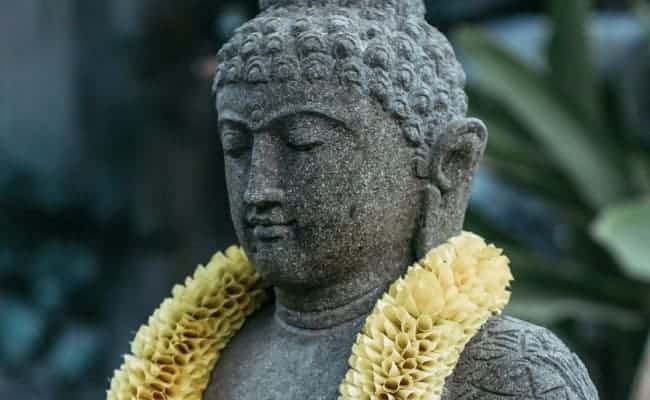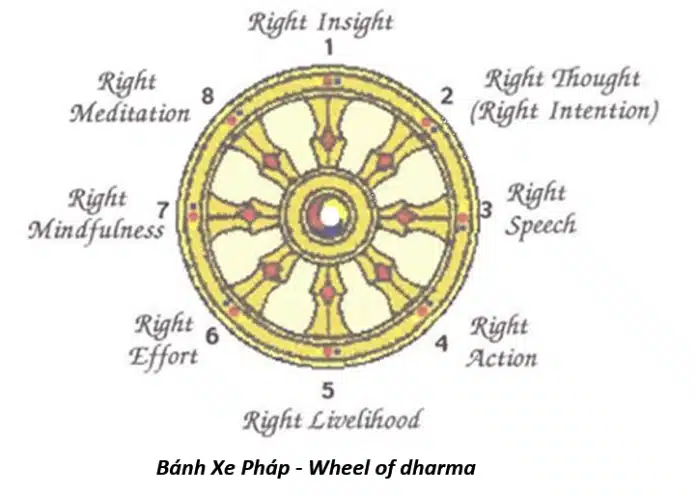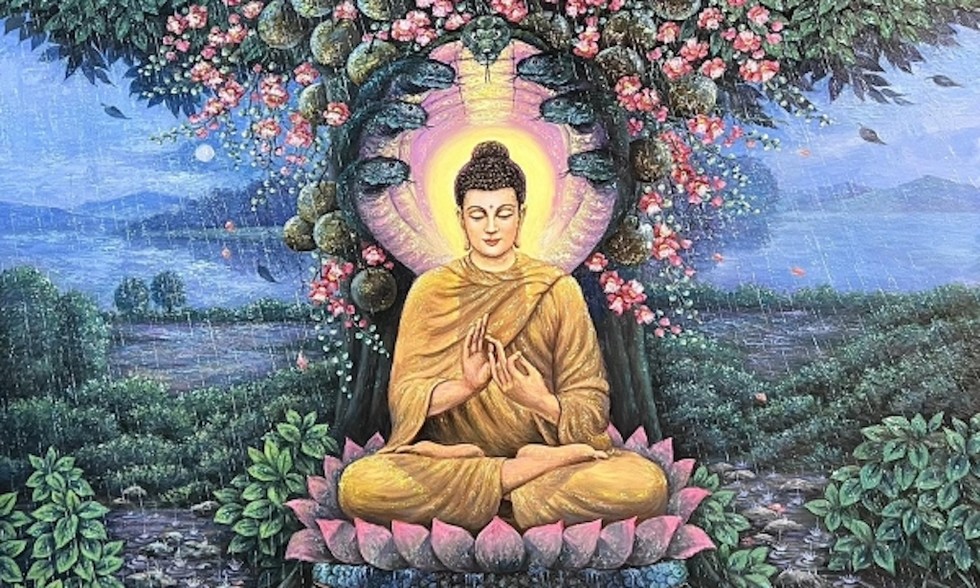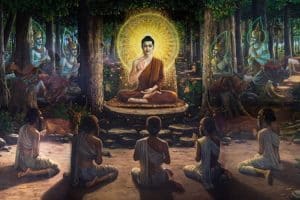Buddha literally means one who is enlightened and awakened — a noble title for the Indian sage. Gotama, who attained enlightenment and proclaimed to the world the truth of liberation, now known by the name of Buddhism.
The Buddha was a historical figure. He was a prince who left his worldly life at the age of twenty-nine to become a monk and find a way to end suffering. He saw the suffering of sentient beings and wanted to save them.
LotusBuddhas also notes that the Buddha is not a god or creator of all living things like other religions, nor is he a deity, a prophet, a savior, or a messenger of God like other religions believe. The Buddha was simply a human being; through the effort of a human being, he became a person with extraordinary wisdom. Everyone, if they want, can become a Buddha like him.
Sometimes people from other religions ask we, “Can the Buddha save us?” and we answer “no.” Hearing the answer “no” may make them discouraged because they think that the Buddha cannot save them. In fact, no one can save another person.
The term “saving” in Buddhism means helping others save themselves. Saving in Buddhism does not mean turning a worldly being into an Enlightened Being or a saint, but rather teaching them, guiding them on the path to Enlightenment, helping them save themselves. In this article, LotusBuddhas will explore in-depth the meaning of the Buddha, role in the Three Jewels, his life and profound teachings.
Meaning of “Buddha”

The term “Buddha” is derived from the Sanskrit root “Budh”, which means “to awaken” or “to understand”. Consequently, “Buddha” is typically translated as “the Awakened One” or “the Enlightened One”. In the context of Buddhist philosophy, this awakening or enlightenment pertains to a profound insight into the true nature of reality, culminating in a liberating knowledge that transcends ordinary human understanding.
“Buddha” is not a personal name, but rather a title that has been applied to a specific historical individual—Siddhartha Gautama. The term is also used more broadly in various Buddhist contexts to denote any being who has independently attained full enlightenment. In Mahayana Buddhism, for instance, the concept of a “Buddha” extends beyond the historical Buddha to include other beings who have achieved enlightenment and may reside in other realms or dimensions of the universe.
In essence, the term “Buddha” encapsulates a spiritual state marked by a deep understanding of the truths of existence, including the understanding of suffering, its origins, its cessation and the path leading to its cessation—the core tenets of Buddhist philosophy encapsulated in the Four Noble Truths. It also implies a transcendence over Samsara, and the attainment of Nirvana, which in Buddhist thought, signifies the ultimate state of liberation and peace.
Who was the Buddha?

The Buddha, often referred to as Siddhartha Gautama or Shakyamuni Buddha, is a prominent figure in the history of religious and philosophical thought, renowned as the founder of Buddhism, one of the world’s major religions. As LotusBuddhas shared above, the word “Buddha” is a title, which means “the Enlightened One” or “the Awakened One”.
Siddhartha Gautama was born into the Shakya clan in the 5th or 6th century BCE in Lumbini, a region now located in present-day Nepal. He was born into privilege as a prince, with early texts illustrating a life of luxury, insulated from the hardships and suffering of the world.
However, according to Buddhist traditions, Siddhartha’s life underwent a profound transformation when he was confronted with the realities of human suffering—old age, sickness and death. This led to what is known as the “Great Departure”, wherein Siddhartha abandoned his royal life and embarked on a spiritual quest to comprehend the nature of suffering and to discover a way to end it.
For years, Siddhartha pursued various paths seeking enlightenment, including asceticism and meditation under various spiritual teachers. His quest culminated in a momentous meditative experience under the Bodhi tree in Bodh Gaya, where he attained a deep understanding of the nature of existence, suffering, and the path to liberation from the samsara. Following this enlightenment, Siddhartha became the Buddha.
The Buddha then spent the remainder of his life, spanning several decades, disseminating his insights and teachings across northern India. The core of these teachings, often referred to as the Dharma, includes the Four Noble Truths and the Eightfold Path—fundamental principles that describe the nature of suffering (dukkha), its cause, its cessation and the path leading to the cessation of suffering.
The Buddha passed away, or achieved Parinirvana, at the age of 80 in Kushinagar, present-day Uttar Pradesh, India. However, his teachings continued to flourish, leading to the establishment of one of the most influential religious and philosophical systems in the world, with diverse Buddhist traditions permeating various cultures across Asia and, eventually, globally.
Throughout the centuries, Buddha’s teachings have been interpreted and integrated into numerous cultures, fostering a range of Buddhist schools and practices. Despite this diversity, the fundamental purpose—attaining liberation from suffering through wisdom, ethical conduct, and mental discipline—remains at the heart of Buddhist tradition. The life and teachings of the Buddha have left an indelible impact on human civilization, contributing substantially to our understanding of human suffering, happiness and the pursuit of a meaningful life.
Qualities of a Buddha
The Buddha is the epitome of enlightenment and awakening, embodying supreme wisdom and purity. A Buddha is someone who has achieved complete enlightenment through their efforts, without reliance on any external assistance. This self-realization is a hallmark of the Buddha’s greatness.
The Buddha’s mind is utterly pure, devoid of common afflictions such as greed, attachment, anger, ignorance, and ego. This purity is a profound attribute, as it signifies an absence of the defilements that usually cloud human minds. While we often find ourselves entangled in desires and aversions, reacting impulsively to likes and dislikes, the Buddha remains undisturbed, embodying perfect equanimity.
For instance, despite being repeatedly targeted by Devadatta, a relative and former disciple intent on harm, the Buddha harbored no ill will. His compassion was unwavering, not just toward Devadatta but equally toward all beings, illustrating his immense and impartial loving-kindness.
This attribute of total purity is not only admirable but also extremely rare and challenging to achieve. It is the result of the Buddha’s extraordinary dedication and practice, a testament to his transcendent virtues.
Another remarkable quality of the Buddha is Omniscience—complete and perfect knowledge. This wisdom was not attained overnight but was the culmination of eons of practice across countless lifetimes, underscoring the vast and committed efforts required to attain such profound understanding.
Just as becoming a skilled physician requires decades of education and training, the Buddha’s enlightenment was the fruition of immense, sustained effort. Understanding this, one can appreciate the depth of his wisdom and why he is revered for his Omniscience.
Yet, this all-encompassing knowledge was never a cause for arrogance but served as a means to guide sentient beings effectively. Through his omniscience, the Buddha knew precisely what to teach, how to teach it, and when, ensuring that his teachings were always relevant and beneficial.
The Buddha possesses numerous other virtues, so many that even if one were to spend an entire lifetime discussing them, it would not suffice. Thus, the qualities of a Buddha are vast and profound, beyond complete articulation in any single account.
What did the Buddha Teach?

Buddha’s teachings, collectively referred to as the Dharma, form the foundational bedrock of Buddhist philosophy and practice. These teachings address the nature of existence, the causes and cessation of suffering, and the path towards ultimate liberation and enlightenment. Among these numerous teachings, Four Noble Truths and Noble Eightfold Path stand as central tenets in all variations of Buddhist tradition.
The Four Noble Truths are:
- The truth of dukkha: Often translated as suffering, dissatisfaction, or stress, dukkha is an inherent characteristic of existence in samsara—the cycle of birth, death and rebirth. Dukkha pervades all conditioned phenomena, encompassing not just physical and mental suffering, but also the pervasive unsatisfactoriness of transient pleasure.
- The truth of the origin of dukkha: This truth asserts that dukkha arises from craving or desire (tanha). This includes craving for sensual pleasure, craving for existence and craving for non-existence.
- The truth of the cessation of dukkha: This truth offers hope, stating that it is possible to bring an end to dukkha. The cessation of dukkha is synonymous with the attainment of Nirvana (Nibbana in Pali), the ultimate goal of Buddhist practice—a state of liberation and peace beyond the realms of samsara.
- The truth of the path leading to the cessation of dukkha: This truth outlines the Noble Eightfold Path, the path that leads to the cessation of dukkha, thereby providing a practical guide to the attainment of Nirvana.
The Noble Eightfold Path is a set of eight interconnected practices or factors that guide the practitioner towards enlightenment. These eight factors are: Right Understanding, Right Thought, Right Speech, Right Action, Right Livelihood, Right Effort, Right Mindfulness and Right Concentration.
- Right Understanding or Right View: This involves understanding the Four Noble Truths, the laws of karma (the ethical law of cause and effect), and the nature of reality.
- Right Thought or Right Intention: This refers to the cultivation of benevolent and compassionate thoughts, free from ill-will and cruelty.
- Right Speech: This involves abstaining from false speech, malicious speech, harsh speech and idle chatter.
- Right Action: This includes abstaining from actions that cause harm, such as killing, stealing and sexual misconduct.
- Right Livelihood: This involves earning a living in ways that do not cause harm or suffering to oneself or others.
- Right Effort: This refers to the cultivation of wholesome qualities and the abandonment of unwholesome qualities.
- Right Mindfulness: This involves the cultivation of clear, nonjudgmental awareness of the present moment, often developed through mindfulness meditation practices.
- Right Concentration: This refers to the cultivation of a deeply focused and tranquil state of mind, often achieved through practices of concentration meditation.
The Buddha’s teachings extend beyond these foundational principles, addressing a wide range of ethical, philosophical and metaphysical topics. His teachings also emphasise the importance of developing wisdom, ethical conduct, and mental discipline (often represented as the Three Higher Trainings) in the path towards enlightenment.
The Role of the Buddha in Three Jewels
Three Jewels, also referred to as the Triple Gem or the Three Refuges, constitute the foundational framework of allegiance and commitment in Buddhism. The three components of the Three Jewels are the Buddha, the Dharma, and the Sangha.
The Buddha: This represents the historical Buddha, Siddhartha Gautama, who attained enlightenment and shared his insights and teachings with the world. The Buddha is venerated as the one who realized the truth of existence and presented the path to liberation. By taking refuge in the Buddha, one expresses trust and confidence in the Buddha as a spiritual guide and acknowledges the potential for awakening within oneself, since each individual is believed to possess Buddha-nature—the inherent capacity to achieve enlightenment.
The Dharma: This represents the teachings of the Buddha—the doctrines and methods presented by him as a guide to achieving enlightenment. Taking refuge in the Dharma signifies a commitment to understanding and practicing these teachings, viewing them as the path towards liberation from suffering.
The Sangha: Traditionally, this refers to the monastic community that has preserved and disseminated the Buddha’s teachings. However, it can also encompass the broader community of individuals who practice the Dharma. Taking refuge in the Sangha represents a commitment to being a part of this community, supporting and being supported by fellow practitioners on the path to enlightenment.
The role of the Buddha in the context of the Three Jewels is paramount. As the original teacher and exemplar, the Buddha is the source of the Dharma and the instigator of the Sangha. By embodying the potential for awakening and liberation, the Buddha serves as the ultimate spiritual model and guide for Buddhist practitioners. Taking refuge in the Buddha signifies an affirmation of the Enlightenment potential inherent in all sentient beings, as well as a commitment to actualizing this potential by following the path outlined in the Dharma and supported by the Sangha.
Therefore, the Buddha, along with the Dharma and the Sangha, forms the cornerstone of Buddhist identity and practice. Together, the Three Jewels provide both the direction and the means for individuals to navigate the path towards liberation and enlightenment.
Do Buddhists Worship the Buddha?

The question of whether Buddhists “worship” the Buddha is a nuanced one, as the term “worship” can carry different connotations depending on the religious or cultural context.
In many forms of Buddhism, the Buddha is highly revered and often the focus of ritual activities. This can include bowing before a statue of the Buddha, offering incense or food, and chanting sutras or mantras associated with the Buddha. However, you must to note that these practices are not considered “worship” in the same sense as in many theistic religions, where worship involves appealing to a deity for divine aid or forgiveness.
Buddhists venerate the Buddha as a supremely enlightened being who discovered the path to liberation from suffering and shared these teachings—the Dharma—with the world. This veneration is an expression of gratitude for his teachings and a reflection of the aspiration to follow in his footsteps by practicing the Dharma. It is also a reminder of the potential for awakening that lies within each individual, as the Buddha taught that all beings have the capacity to realize enlightenment.
So, while Buddhists express deep respect and devotion towards the Buddha, it’s more accurate to describe this as veneration or reverence rather than “worship” in the Western theistic sense. Buddhists do not view the Buddha as an omnipotent god or as an intercessor who can grant wishes or absolve sins. Instead, they see him as a guide and teacher, whose teachings provide a roadmap for navigating life’s challenges and ultimately achieving enlightenment.
In this context, the central focus of Buddhism is not worship, but rather understanding and practicing the Dharma—applying the Buddha’s teachings to one’s own life in order to cultivate wisdom, ethical conduct and mental discipline. In doing so, Buddhists aim to realize the same awakening that the Buddha himself achieved.
How did the Buddha Attain Enlightenment?

The Buddha’s journey to enlightenment, as recounted in traditional Buddhist texts, was a profound and transformative process. Born Siddhartha Gautama, a prince of the Shakya clan in what is now modern-day Nepal, he lived a sheltered life of luxury until he was confronted with the harsh realities of human existence: old age, sickness and death. This encounter sparked a deep existential crisis, prompting Siddhartha to renounce his royal life in pursuit of a solution to human suffering—a period often referred to as the “Great Departure”.
Siddhartha first sought wisdom from renowned spiritual teachers of his time, mastering their teachings and meditative techniques. However, he found that while these practices led to profound states of mind, they did not bring about the enduring end to suffering he sought. He then experimented with extreme asceticism, pushing his body to the limits through fasting and other rigorous practices. But this approach, too, proved unsatisfactory, as it weakened his body without bringing him closer to understanding the nature of suffering.
Realizing that neither sensual indulgence nor self-mortification led to enlightenment, Siddhartha pursued a ‘Middle Way’—a path of moderation away from the extremes of self-indulgence and self-torment. He began to eat nourishing food again and prepared himself for a deep meditation under a tree at Bodh Gaya in India.
In what is often depicted as a night-long intense meditation, Siddhartha reportedly confronted and overcame various fears, doubts and temptations personified as the demon Mara. By the light of the morning star, Siddhartha gained profound insight into the nature of reality, breaking through the cycle of ignorance and suffering. This breakthrough, known as Enlightenment or Awakening, transformed him into the Buddha—the Awakened One.
After achieving enlightenment, the Buddha spent the rest of his life teaching others the path he had discovered, hoping to help them attain the same liberation from suffering. His teachings, known as the Dharma, became the foundation of Buddhism and continue to guide practitioners to this day.
Have There Been Other Buddhas?

According to Buddhist tradition and doctrine, there have been other Buddhas besides Siddhartha Gautama, who is the most well-known Buddha in our current era. In the broader Buddhist cosmology and chronology, numerous Buddhas are said to have arisen in different world systems and epochs.
The concept of multiple Buddhas is particularly emphasized in Mahayana Buddhism and the related school of Tantric Buddhism. The Lotus Sutra, a key Mahayana text, for example, describes a cosmos filled with countless Buddhas across myriad worlds. Some of these Buddhas, such as Amitabha Buddha and Medicine Buddha, are significant figures of devotion in certain Mahayana traditions.
In addition, there are teachings about Buddhas who preceded Siddhartha Gautama and those who will follow him. Theravada tradition, for instance, recognizes a line of 28 Buddhas culminating in Gautama Buddha. The Buddha himself, in the Pali Canon, mentions some of these past Buddhas by name and describes their lives as having similarities with his own.
The next Buddha to come, known as the Future Buddha or Maitreya (Metteyya in Pali), is a figure shared across Theravada, Mahayana and Vajrayana traditions. Maitreya is believed to currently reside in the Tusita heaven, waiting for the appropriate time to be born into the human world and achieve complete enlightenment, after which he will teach the Dharma just as Gautama Buddha did.
You have to note that while the specific names and characteristics of these past and future Buddhas may vary across different Buddhist traditions, they are all considered to have reached or will reach the same ultimate state of awakening as Gautama Buddha. Furthermore, the doctrine of multiple Buddhas underscores a key belief in Buddhism—that enlightenment is not exclusive to a single being, but is a potential that can be realized by all sentient beings.






